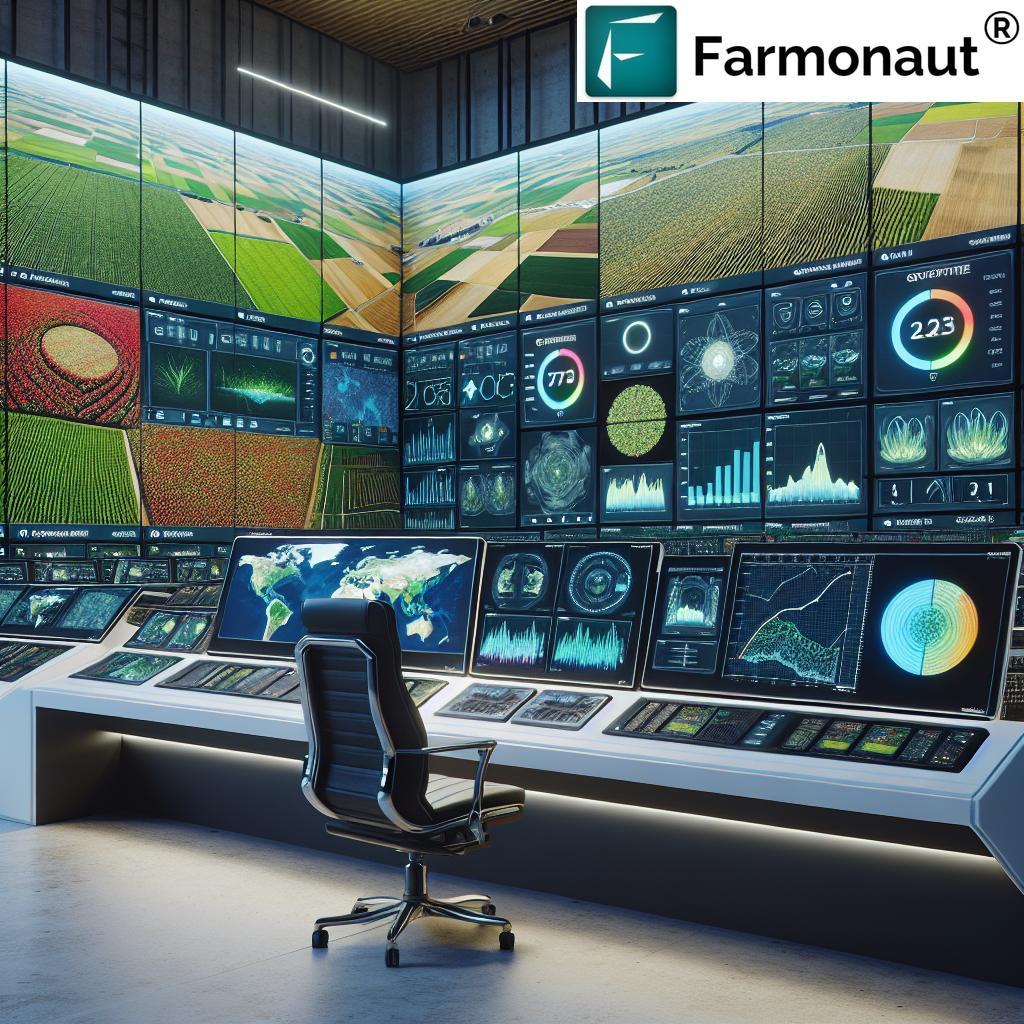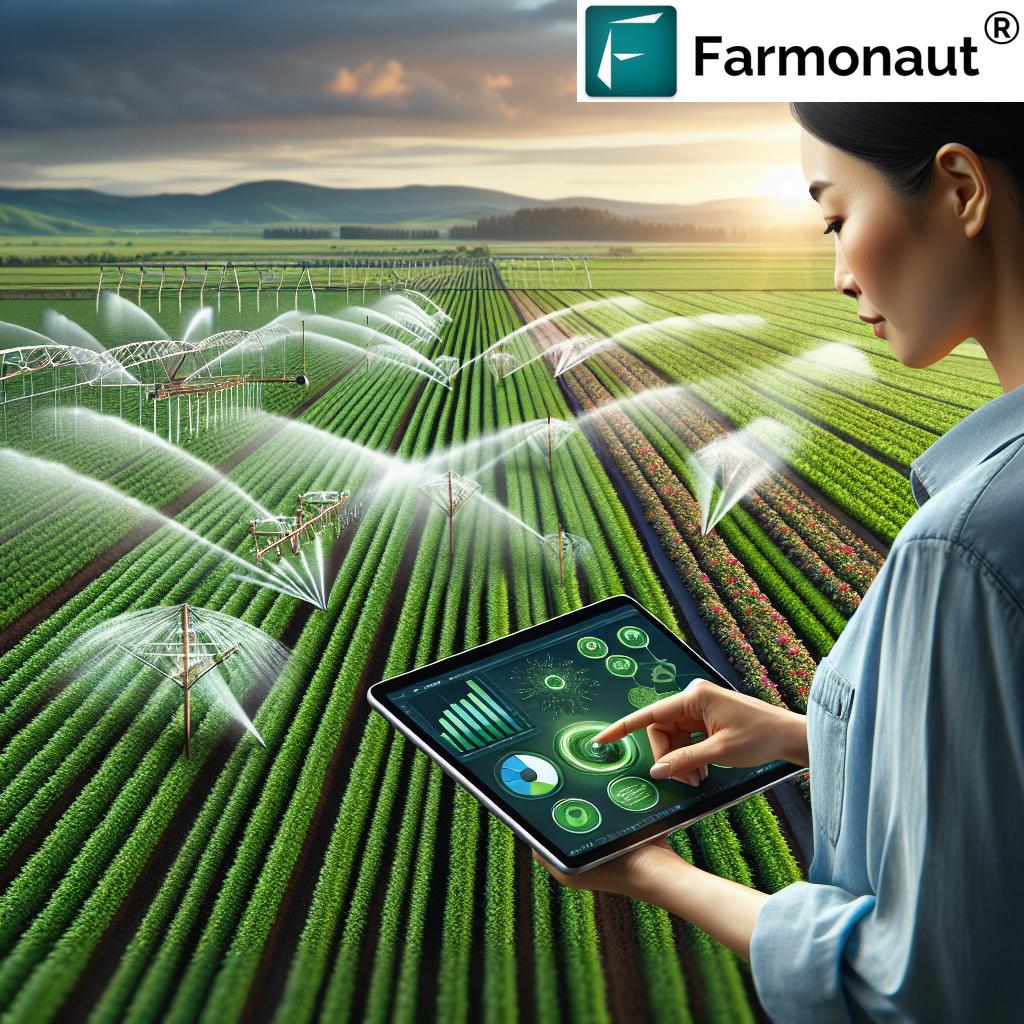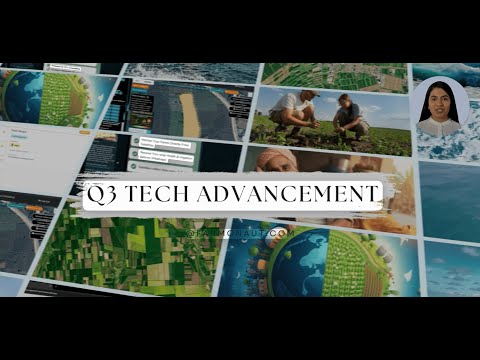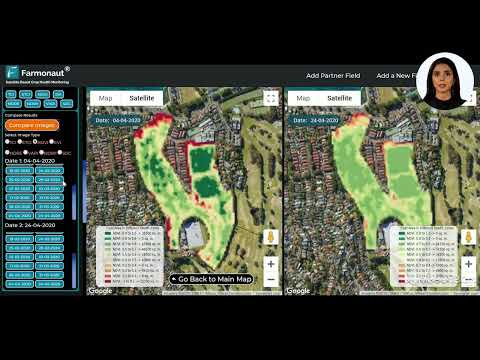“Precision agriculture technologies can increase crop yields by up to 30% while reducing water usage by 20-50%.”
In the ever-evolving landscape of modern agriculture, we are witnessing a remarkable transformation driven by precision farming and remote sensing technologies. As experts in the field, we at Farmonaut are at the forefront of this agricultural revolution, leveraging cutting-edge technologies to enhance crop yields, promote sustainability, and optimize resource management. In this comprehensive guide, we’ll explore how these innovative approaches are reshaping the farming industry and paving the way for a more efficient and environmentally conscious future.
The Dawn of Precision Agriculture
Precision agriculture represents a paradigm shift in farming practices, offering a data-driven approach to crop management that maximizes efficiency and minimizes waste. By integrating advanced technologies such as satellite imaging, GPS mapping, and IoT sensors, farmers can make informed decisions about every aspect of their operations, from planting to harvest.
- Improved resource allocation
- Enhanced crop health monitoring
- Optimized irrigation management
- Precise fertilizer application
- Effective pest and disease control
These precision agriculture technologies are revolutionizing the way we approach farming, allowing for unprecedented levels of control and insight into crop development and environmental conditions.

Remote Sensing: The Eyes in the Sky
Remote sensing in farming has emerged as a game-changing tool for agricultural monitoring and management. By harnessing the power of satellite imagery and aerial observations, farmers can gain valuable insights into their crops’ health, soil conditions, and potential threats, all without setting foot in the field.
“Remote sensing in agriculture can detect crop stress up to 2 weeks earlier than visual inspection, improving response time.”
Key benefits of remote sensing include:
- Early detection of crop stress and disease
- Accurate yield predictions
- Monitoring of soil moisture levels
- Identification of nutrient deficiencies
- Assessment of crop damage from natural disasters
At Farmonaut, we’ve integrated advanced remote sensing capabilities into our farm management software, providing farmers with real-time data and actionable insights to drive informed decision-making.
Crop Monitoring Systems: The Pulse of Modern Agriculture
Crop monitoring systems are the backbone of precision agriculture, offering farmers a comprehensive view of their fields’ health and performance. These systems combine various data sources, including satellite imagery, ground sensors, and weather information, to create a holistic picture of crop development.
Our advanced crop monitoring systems at Farmonaut enable farmers to:
- Track vegetation indices like NDVI (Normalized Difference Vegetation Index)
- Monitor crop growth stages
- Identify areas of stress or underperformance
- Analyze historical crop data for trend identification
- Generate customized reports and alerts
By leveraging these tools, farmers can proactively address issues before they escalate, leading to improved crop health and higher yields.
Smart Irrigation Solutions: Conserving Water, Boosting Yields
Water scarcity is a growing concern in agriculture, making efficient irrigation management crucial for sustainable farming. Smart irrigation solutions leverage data from soil moisture sensors, weather forecasts, and crop water requirements to optimize water usage.
Benefits of smart irrigation include:
- Reduced water consumption
- Improved crop quality and yield
- Prevention of over-watering and related issues
- Lower energy costs for pumping
- Minimized nutrient leaching
Our farm management software integrates with smart irrigation systems, allowing farmers to automate and fine-tune their watering schedules based on real-time data and predictive analytics.
Agricultural Data Analytics: Turning Information into Action
The true power of precision agriculture lies in its ability to transform vast amounts of data into actionable insights. Agricultural data analytics combines information from various sources to provide farmers with a comprehensive understanding of their operations and guide decision-making.
Key areas where data analytics drives value include:
- Yield forecasting and optimization
- Resource allocation and planning
- Risk assessment and management
- Precision fertilizer application
- Pest and disease prediction
At Farmonaut, we’ve developed sophisticated algorithms that process and analyze agricultural data, providing farmers with clear, actionable recommendations to improve their operations.

Sustainable Farming Practices: The Future of Agriculture
As the global population continues to grow, the need for sustainable farming practices becomes increasingly crucial. Precision agriculture and remote sensing technologies play a vital role in promoting sustainability by optimizing resource use and minimizing environmental impact.
Sustainable farming practices enabled by these technologies include:
- Reduced chemical inputs through targeted application
- Improved soil health management
- Conservation of water resources
- Minimized soil erosion and nutrient runoff
- Enhanced biodiversity through precision pest management
Our farm management software is designed with sustainability in mind, helping farmers implement and track eco-friendly practices while maintaining high productivity levels.
Precision Fertilizer Application: Optimizing Nutrient Management
Precision fertilizer application is a key component of sustainable agriculture, allowing farmers to apply nutrients exactly where and when they’re needed. This approach not only improves crop yields but also reduces environmental impact and costs associated with over-fertilization.
Benefits of precision fertilizer application include:
- Improved nutrient use efficiency
- Reduced fertilizer waste and runoff
- Enhanced crop quality and yield
- Lower input costs for farmers
- Minimized soil and water pollution
Our platform integrates soil testing data, crop nutrient requirements, and historical yield information to generate precise fertilizer recommendations, ensuring optimal nutrient management across the farm.
Crop Yield Optimization: Maximizing Farm Productivity
Crop yield optimization is the ultimate goal of precision agriculture, combining all aspects of farm management to maximize productivity. By leveraging data-driven insights and advanced technologies, farmers can identify and address factors limiting their yields.
Key strategies for crop yield optimization include:
- Variable rate seeding based on soil conditions
- Precision irrigation and fertilization
- Targeted pest and disease management
- Optimized harvest timing
- Continuous monitoring and adjustment of farming practices
Our farm management software provides comprehensive yield analysis tools, allowing farmers to track performance, identify trends, and make data-driven decisions to boost productivity.
Agricultural Commodity Market Trends: Navigating Market Dynamics
Understanding agricultural commodity market trends is crucial for farmers looking to maximize their profits and manage risk. Precision agriculture technologies can provide valuable insights into market dynamics, helping farmers make informed decisions about crop selection, pricing, and timing of sales.
Key factors influencing agricultural commodity markets include:
- Global supply and demand fluctuations
- Weather patterns and natural disasters
- Government policies and trade agreements
- Currency exchange rates
- Energy prices and biofuel demand
Our platform integrates market data and analysis tools, allowing farmers to stay informed about commodity prices, futures contracts, and market forecasts, enabling them to make strategic decisions about their operations.
GIS and Remote Sensing in Agriculture: Mapping the Future of Farming
Geographic Information Systems (GIS) and remote sensing technologies are revolutionizing the way we understand and manage agricultural landscapes. These tools provide farmers with detailed spatial information about their fields, enabling precise management of resources and crop production.
Applications of GIS and remote sensing in agriculture include:
- Field mapping and boundary delineation
- Soil type and quality assessment
- Crop health monitoring and stress detection
- Yield mapping and prediction
- Precision application of inputs
At Farmonaut, we’ve integrated advanced GIS and remote sensing capabilities into our farm management software, providing farmers with powerful tools for spatial analysis and decision-making.
Pest Management in the Digital Age
Effective pest management is crucial for maintaining crop health and maximizing yields. Precision agriculture technologies have transformed pest control strategies, allowing for more targeted and efficient interventions.
Advanced pest management techniques include:
- Remote sensing for early pest detection
- Precision application of pesticides
- Integrated Pest Management (IPM) strategies
- Predictive modeling for pest outbreaks
- Biological control methods
Our farm management software incorporates pest monitoring tools and predictive algorithms to help farmers implement proactive pest management strategies, reducing chemical use and improving crop protection.
Harvest Prediction: Timing is Everything
Accurate harvest prediction is essential for optimizing farm operations, managing labor resources, and maximizing crop quality. Precision agriculture technologies enable farmers to forecast harvest dates with greater accuracy, based on real-time crop development data and historical patterns.
Benefits of precise harvest prediction include:
- Improved crop quality through optimal timing
- Efficient resource allocation
- Better coordination with buyers and processors
- Reduced post-harvest losses
- Enhanced market timing for maximum profitability
Our platform provides advanced harvest prediction tools, integrating crop growth models, weather data, and historical information to generate accurate forecasts for each field.
The Role of AI and Machine Learning in Agriculture
Artificial Intelligence (AI) and Machine Learning (ML) are increasingly playing a crucial role in precision agriculture, enabling more sophisticated analysis and decision-making processes. These technologies can process vast amounts of data to identify patterns, make predictions, and generate insights that would be impossible for humans to achieve manually.
Applications of AI and ML in agriculture include:
- Crop disease detection and diagnosis
- Yield prediction and optimization
- Autonomous farm equipment operation
- Personalized crop management recommendations
- Weather forecasting and risk assessment
At Farmonaut, we’re continually developing and integrating AI and ML capabilities into our farm management software, providing farmers with cutting-edge tools to enhance their operations.
The Economic Impact of Precision Agriculture
The adoption of precision agriculture technologies has significant economic implications for farmers and the agricultural industry as a whole. While there may be initial investment costs, the long-term benefits often outweigh these expenses.
Economic advantages of precision agriculture include:
- Increased crop yields and quality
- Reduced input costs (fertilizers, pesticides, water)
- Improved resource efficiency
- Enhanced farm profitability
- Better risk management and decision-making
Our farm management software is designed to help farmers maximize their return on investment in precision agriculture technologies, providing tools for cost-benefit analysis and performance tracking.
Comparison: Traditional vs. Precision Farming Techniques
| Farming Aspect | Traditional Method | Precision Farming Technique | Estimated Yield Improvement (%) | Estimated Resource Savings (%) | Environmental Impact |
|---|---|---|---|---|---|
| Irrigation | Uniform watering across fields | Variable rate irrigation based on soil moisture sensors | 15-25% | 30-50% water savings | Reduced water waste and runoff |
| Fertilizer Application | Blanket application across fields | Precision application based on soil tests and crop needs | 10-20% | 20-40% fertilizer savings | Reduced nutrient pollution in waterways |
| Pest Management | Scheduled spraying of entire fields | Targeted application based on pest detection | 5-15% | 40-60% pesticide savings | Reduced chemical usage and improved biodiversity |
| Crop Monitoring | Visual inspection and manual sampling | Satellite and drone imagery, IoT sensors | 10-30% | 20-40% labor savings | Early detection of issues, reduced crop losses |
| Harvest Timing | Based on calendar dates and visual cues | Data-driven prediction using growth models and sensors | 5-10% | 10-20% reduction in post-harvest losses | Optimized quality and reduced food waste |
The Future of Precision Agriculture
As technology continues to advance, the future of precision agriculture looks increasingly promising. Emerging trends and technologies that will shape the future of farming include:
- Integration of blockchain for improved traceability and transparency
- Advanced robotics and autonomous farm equipment
- Hyperspectral imaging for more detailed crop analysis
- Gene editing and precision breeding techniques
- IoT-enabled smart farms with end-to-end automation
At Farmonaut, we’re committed to staying at the forefront of these technological advancements, continuously updating our platform to provide farmers with the most cutting-edge tools and insights available.
Conclusion: Embracing the Agricultural Revolution
The integration of precision farming and remote sensing technologies is ushering in a new era of agriculture, one that promises higher yields, improved sustainability, and enhanced profitability for farmers worldwide. By leveraging these advanced tools and techniques, we can address the growing global demand for food while minimizing our environmental impact.
As we’ve explored in this comprehensive guide, the benefits of precision agriculture are far-reaching, from optimized resource management to data-driven decision-making. At Farmonaut, we’re proud to be at the forefront of this agricultural revolution, providing farmers with the tools and insights they need to thrive in this new landscape.
We invite you to join us in embracing these transformative technologies. Whether you’re a small-scale farmer or managing large agricultural operations, our farm management software can help you unlock the full potential of your land and resources.
Ready to revolutionize your farming practices? Explore our solutions today:
For developers interested in integrating our powerful agricultural data into their own applications, check out our API and API Developer Docs.
FAQ: Precision Agriculture and Remote Sensing
Q: What is precision agriculture?
A: Precision agriculture is a farming management concept that uses technology to observe, measure, and analyze the needs of individual fields and crops. It allows farmers to optimize their inputs and practices for improved efficiency and sustainability.
Q: How does remote sensing benefit farmers?
A: Remote sensing provides farmers with valuable data about their crops and field conditions without the need for physical inspection. It can detect issues early, monitor crop health, and help in making informed decisions about irrigation, fertilization, and pest control.
Q: Is precision agriculture only for large farms?
A: No, precision agriculture can benefit farms of all sizes. While some technologies may have been initially developed for larger operations, many solutions, including Farmonaut’s platform, are designed to be accessible and beneficial for small to medium-sized farms as well.
Q: How does precision agriculture contribute to sustainability?
A: Precision agriculture promotes sustainability by optimizing resource use, reducing waste, and minimizing environmental impact. It allows for targeted application of inputs, conserves water, and helps maintain soil health.
Q: What kind of return on investment can I expect from implementing precision agriculture technologies?
A: The ROI can vary depending on factors such as farm size, crop type, and specific technologies implemented. However, many farmers report significant improvements in yield (10-30%) and reductions in input costs (20-40%), leading to enhanced profitability over time.







